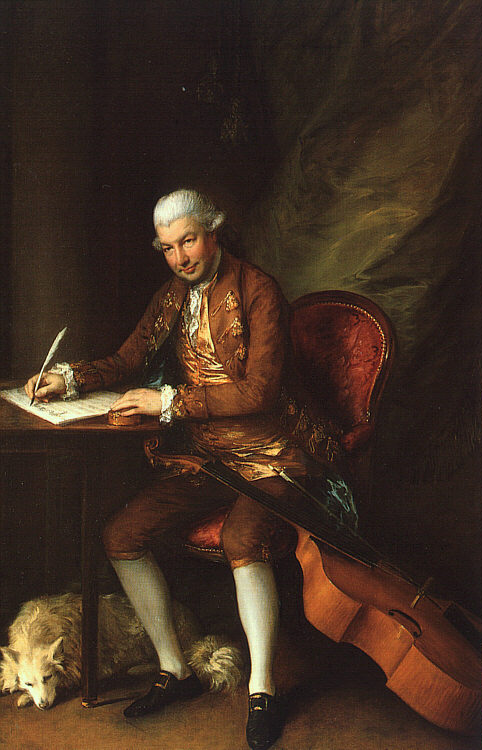
To begin a series on pooches in paintings, I wanted to open with one of my favourite human-dog portraits. Thomas Gainsborough's portrait of the composer Carl Friedrich Abel depicts the music man as if we have just interrupted him in his study. The busy musician looks up from his work that he has been pouring onto paper before the notes leave his head. His cello (musicians, feel free to correct me if I'm wrong!) casually leans against his leg, so he can quickly play the tunes he hears and then go back to recording them on paper. Abel is obviously successful in his musical career. The grandness of his fine chair, the drapery, and even his copper coloured silk vest excrete wealth and success. He is enlightened man because of his connection to music...and nature.
Sleeping calmly at his master's feet is Abel's dog. The faithful companion is the only one allowed in Abel's private study while he works. We can see why, he is a quiet audience. The dog's presence evokes a sense of calm and gives the viewer a sense of comfort about the sitter and his personality. In fact, the dog completes the portrait; it would be unbalanced without him. Gainsborough, a big dog fan, puts a lights source on both Abel's face and the dog's. The rest of his fluffy white body is shadowed under the desk. If you think only a crazy dog-lover would zone in on the pooch in the painting, let me reiterate how much the people of the 18th century loved their dogs. When the painting was exhibited, the St James Chronical reported on "the correctness" of Gainsborough's execution of the dog. Ya know, just in case you were worried that the dog didn't come out right!
If you were wondering about that music Carl was composing in the painting, I put together a sampling of it below. It gave me an excuse to play with the amazon mp3 player! So now you can make like Abel's puppy and relax to the sounds of his strings.

I love the music! Heather, I could live on your blog!!!
ReplyDeletePeople in the 18th century really did love their dogs. Pugs were also very popular, especially in France, where they had litters of them! Oh, you've inspired me...must write a post about this soon! Thanks,
Lucy
I think this is actually a viola de gamba, which was sort of like a precursor to the cello. It tends to have a warmer tone than a cello and requires a different bow. It also sounds best in drawing room type situations, which means it was great during the baroque and classical period, but once you get to the real sturm und drang type stuff, the viola de gamba can't be heard at all. Ergo, the cello.
ReplyDeleteEr, sorry for the ramble.
Ms Lucy-
ReplyDeleteYes! I even wrote a post about pugs
a while back which, of course, included the story about your Josephine!
Elyse-
Thank you for the ramble, I'm glad I asked now! That's so interesting, I'm glad your a music aficionado!
Well, I have to stop dead in my tracks then! I was just about to post something on Pugs!! Better yet; why don't I link it right back to your blog?
ReplyDeleteLucy
Thanks for including the music. I just loved it!
ReplyDeleteI think the handsome dog may be Gainsborough's studio model, as s/he appears in The Morning Walk (or whatever it's called), shown in the Picture Hat post. As well as another painting called The Mall, which is at the at the Fabulous Frick. (I bet Heather has it on here somewhere.) I'm sure poochie makes appearances in other portraits I can't recall.
Hope we get to see a Pug soon.
Lucy- Don't let me stop you, by all means, write your post! :)
ReplyDeletePolonaise-
That's a really good point. I'm pretty sure that the dog from the morning walk was a studio dog, perhaps this was too. However, the white Pomeranians were popular pets at this time too. In fact the Prince of Wales had one, but that's a a story for another time!
I was just about to ask what sort of dog that is! I wonder how much breeds have changed since that time. The only dogs I know anything about are labs. It's hard to believe that until recently people lived without labrador retrievers!
ReplyDeleteLovely picture--and I DO like the music :D . Might we hope to one day see an epic posts on People and pets in 18th century portraiture?
ReplyDeleteThis is such a great idea for a series of posts. Talk about "going to the dogs" indeed. Of course, I thought of the story of Mary Stuart's little dog cowering under her skirts during her execution -- but that's a different century.
ReplyDeleteAlso, you've won the Butterfly Award for excellence over on my blog here:
http://tinyurl.com/bt8yv8
Heather! I couldn't resist! I wrote the post and I linked you. Go check it out;-)
ReplyDeleteLucy www.enchantedbyjosephine.blogspot.com
I do find it so interesting how much dog breeds have changed through the years. You never see Pomerians like this anymore, these look more like American Eskimo dogs! And yes, I do plan on continuing the series on dogs and their humans in portraiture :)
ReplyDeleteKris-
Thank you so much! I guess it is only fitting that Georgiana's gossip guide should have a lot about dogs, since she married into a very dog-loving family!